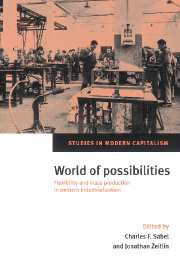Book contents
- Frontmatter
- Contents
- List of contributors
- Acknowledgments
- Stories, strategies, structures: rethinking historical alternatives to mass production
- Part I The modernity of tradition
- Part II The battle of the systems
- Part III The resurgence of flexible production
- 9 In search of flexibility: the Bologna metalworking industry, 1900–1992
- 10 Local industry and actors' strategies: from combs to plastics in Oyonnax
- 11 Producing producers: shippers, shipyards and the cooperative infrastructure of the Norwegian maritime complex since 1850
- Index
10 - Local industry and actors' strategies: from combs to plastics in Oyonnax
Published online by Cambridge University Press: 12 December 2009
- Frontmatter
- Contents
- List of contributors
- Acknowledgments
- Stories, strategies, structures: rethinking historical alternatives to mass production
- Part I The modernity of tradition
- Part II The battle of the systems
- Part III The resurgence of flexible production
- 9 In search of flexibility: the Bologna metalworking industry, 1900–1992
- 10 Local industry and actors' strategies: from combs to plastics in Oyonnax
- 11 Producing producers: shippers, shipyards and the cooperative infrastructure of the Norwegian maritime complex since 1850
- Index
Summary
The industrial development of the area round Oyonnax, in the French Jura close to Switzerland, represents another chapter in a very long story. The current vigorous development of the plastics moulding industry there owes a great deal to the renewal of an age-old tradition of small businesses specializing in working first with horn and later with celluloid. Throughout its history local industry has managed to keep on adapting to constant changes in markets, production techniques and the populations that provide its labor force. But the processes of adaptation, often fraught, have frequently involved profound changes both in the local way of managing industry and in local society.
The presence on the spot of many of the actors involved in these changes enables us not just to reconstruct the economic history of this area, but also to attempt to understand how the actors themselves construct their perception of their situation, and what meaning they attribute to industrial development and to their experiences of conflict and cooperation. The study of an example like this enables us to establish the main lines of an economic sociology adapted to French situations of this very particular kind.
Industrial development and urban growth in Oyonnax
Typical explanations of the implantation and development of an industrial city will refer either to specific features of its site – coal deposits, sources of hydraulic energy or water with particular chemical qualities, or some other resource above or below ground – or to the strategic location of the site in a position that makes it the key to an important through route.
- Type
- Chapter
- Information
- World of PossibilitiesFlexibility and Mass Production in Western Industrialization, pp. 419 - 460Publisher: Cambridge University PressPrint publication year: 1997
- 4
- Cited by



